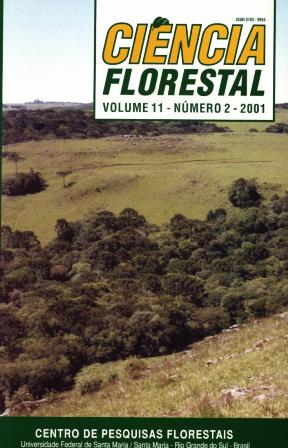GROWTH OF NATIVE SPECIES OF THE DECIDUOUS/DENSE TROPICAL FOREST OF RIO GRANDE DO SUL
DOI:
https://doi.org/10.5902/198050981659Keywords:
Stem analysis, native species, Rio Grande do Sul.Abstract
The tree species caúna-da-serra (Ilex brevicuspis Reissek.), cocão (Erythroxilum deciduum), tarumã-de-espinho (Cytharexylum montevidense Sprenger) e capororoca (Rapanea ferruginea (Ruiz & Pavon) Mez), native in the deciduous seasonal forest / dense tropical forest of Santa Maria were studied using a retrospective analysis. A stem analysis was performed of each species, measuring annual growth rings. Volume growth, commercial form factor and the annual percentual increment of commercial volume were analyzed according to growth at diameter at breast height. For modelling purposes 5 different equations were tested. It could be shown that a polynome of second degree was best adjusted to the growth of commercial volume and commercial form factor while annual percentual increment of commercial volume showed best fit with an exponential function. A significantly different accumulation of volume could be found concerning the different species which were studied. While tarumã and cocão show a rapid accumulation in growth, caúna and capororoca grow more slowly. This is correlated with more cylindric stems in the case of tarumã and cocão. The annual percentual increment of commercial volume moves between the range of more than 100% at the beginning of the growth process and below 10% at the end of the studied growth period.
Downloads
References
AMARAL JUNIOR, A. Flora ilustrada catarinense: Eritroxiláceas. Itajaí: Herbário Barbosa Rodrigues, 1980. 64 p.
CARVALHO, P.E.R. Espécies florestais brasileiras, recomendações silviculturais, potencialidades e uso da madeira. Brasilia: Embrapa/CNPF, 1994. 640 p.
EDWIN, G., REITZ, R. Flora ilustrada catarinense: aquifoliáceas. Itajaí: Herbário Barbosa Rodrigues, 1967.
FINGER, C.A.G. Fundamentos da biometria florestal. Santa Maria: UFSM/CEPEF/FATEC, 1992. 269 p.
LAMPRECHT, H. Silvicultura nos trópicos. Eschbom: GTZ, 1990, 343p.
LONGHI, S.J.; VACCARO, S.; BUENO COELHO, M.C. et al. Análise fitosociológica de um remanescente de floresta ombrófila mista em Itaára, Santa Maria – RS: SIMPÓSIO SOBRE ECOSSISTEMAS NATURAIS DO MERCOSUL, 1., 1996, Santa Maria. Anais... Santa Maria, 1996. p. 79-89.
MAIXNER, A.E., FERREIRA, L.A.B. Contribuição ao estudo das essências florestais e frutíferas nativas no Rio Grande do Sul. Trigo e Soja, v. 28, p. 2-27, 1978.
MITSCHERLICH, G. Der Fichten-Tannen-(Buchen)-Plenterwald. Schriftenr. Bad. Forstl. Versuchsanstalt, Freiburg i. Br., v. 8, p. 3-42, 1952.
MORENO, J.A. Clima do Rio Grande do Sul. Porto Alegre: Secretaria da Agricultura-RS, 1961.
p.
REITZ, R.; KLEIN, R.M.; REIS, A. Projeto madeira do Rio Grande do Sul. Porto Alegre: CORAG, 1988. 525 p.
SANCHOTENE, M. Frutíferas nativas úteis à fauna na arborização urbana. Porto Alegre: FEPLAM, 1985. 311 p.
SCHULZ, O.E. Erythroxylaceae. In: Engler. Das Pflanzenreich, 1907. p. 1-176.
SOBRAL, M. Erythroxylum no Rio Grande do Sul, Brasil. Porto Alegre: UFRGS, 1990.
p.
VACCARO, S.; LONGHI, S.J. Análise fitossociológica de algumas áreas remanescentes da floresta do Alto Uruguay, entre os rios de Ijuí e Turvo, no Rio Grande do Sul. Ciência Florestal, v. 5, p. 33-54, 1995.
ZEIDE, B. Analysis of growth equations. Forest Science, v. 39, n. 3, p. 594-616, 1993.







